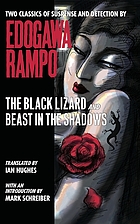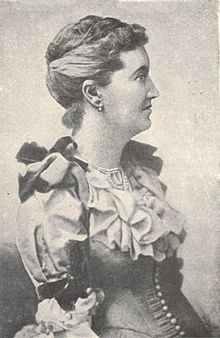"Outside was the boulevard at night, like a land of death where only the streetlights and asphalt were visible."
-- Setting the tone of The Black Lizard (7)
I have meant to read this famous Japanese thriller (originally published in 1934) for at least a decade, largely based on the reputation of the 1968 film adaptation, which I still haven't seen. There's never been a legitimate home video/DVD release, that I can find, although I just discovered it's on YouTube. So it's strange that when I finally did, the timing made me aware of its numerous similarities to the The Sorceress of the Strand!
There's a beautiful woman at the head of a vast criminal network, who covets famous jewels, befriends the young women she plans to victimize, and enjoys close-quarters cat-and-mouse games with the detective on the case. Even the style, relatively straight-to-the-point, at least in the 2006 English translation, has more in common with Meade's than it does that of a Poe or a Conan Doyle.
Instead of operating out of a posh beauty salon, though, this mastermind, who I kept thinking of as the Girl with the Lizard Tattoo, seems to have kidnapping and jewelry theft as her main occupations. And she's far less inhibited, introduced dancing naked at a Christmas Eve party, which shows off that lifelike tattoo: "it seemed as if it would crawl from shoulder to neck, neck to chin, and to her red and shining lips" (5).
That definitely sets a tone, and her plan to steal both a jeweler's prize gem and his beautiful daughter leads to a lot more nudity and general weirdness. Followed by the intrepid Detective Akechi Kogoro, himself a master of disguise and deception, the Black Lizard takes her victim to a perverse art museum/full-on Bond villain lair, complete with a human-scale aquarium, former victims stuffed and posed as trophies, and a man (who may be a kidnapped movie star) naked in a giant cage. The baroque quality of all this has a lot more in common with something like 1968's Danger: Diabolik than it does, say, noir stalwart Raymond Chandler, whose first novel wouldn't be published until five years after this one.
Along the way, there's an amount of direct address to the reader, which makes it feel like an old-time serial (or maybe the '60s Batman series), with rhetorical questions about the plot and statements like "doubtless the reader will have divined that this dark-garbed woman was none other than our heroine, the Black Lizard" (30).
I was interested to see that, by 1934, some people in Japan were already wearing gauze face masks, "commonly used to prevent colds from spreading" (103), which comes in handy when escaping the police, and that Akechi enlists the aid of a "modern girl of somewhat dubious morals" in his plans (167), since that gives her the "guts" to stand up to the stress.

Edogawa, Rampo, Ian Hughes, Mark Schreiber, and Hiroaki Kawajiri. The Black Lizard and Beast in the Shadows. Fukuoka, Japan: Kurodahan Press, 2006.
-- Setting the tone of The Black Lizard (7)
I have meant to read this famous Japanese thriller (originally published in 1934) for at least a decade, largely based on the reputation of the 1968 film adaptation, which I still haven't seen. There's never been a legitimate home video/DVD release, that I can find, although I just discovered it's on YouTube. So it's strange that when I finally did, the timing made me aware of its numerous similarities to the The Sorceress of the Strand!
There's a beautiful woman at the head of a vast criminal network, who covets famous jewels, befriends the young women she plans to victimize, and enjoys close-quarters cat-and-mouse games with the detective on the case. Even the style, relatively straight-to-the-point, at least in the 2006 English translation, has more in common with Meade's than it does that of a Poe or a Conan Doyle.
Instead of operating out of a posh beauty salon, though, this mastermind, who I kept thinking of as the Girl with the Lizard Tattoo, seems to have kidnapping and jewelry theft as her main occupations. And she's far less inhibited, introduced dancing naked at a Christmas Eve party, which shows off that lifelike tattoo: "it seemed as if it would crawl from shoulder to neck, neck to chin, and to her red and shining lips" (5).
That definitely sets a tone, and her plan to steal both a jeweler's prize gem and his beautiful daughter leads to a lot more nudity and general weirdness. Followed by the intrepid Detective Akechi Kogoro, himself a master of disguise and deception, the Black Lizard takes her victim to a perverse art museum/full-on Bond villain lair, complete with a human-scale aquarium, former victims stuffed and posed as trophies, and a man (who may be a kidnapped movie star) naked in a giant cage. The baroque quality of all this has a lot more in common with something like 1968's Danger: Diabolik than it does, say, noir stalwart Raymond Chandler, whose first novel wouldn't be published until five years after this one.
Along the way, there's an amount of direct address to the reader, which makes it feel like an old-time serial (or maybe the '60s Batman series), with rhetorical questions about the plot and statements like "doubtless the reader will have divined that this dark-garbed woman was none other than our heroine, the Black Lizard" (30).
I was interested to see that, by 1934, some people in Japan were already wearing gauze face masks, "commonly used to prevent colds from spreading" (103), which comes in handy when escaping the police, and that Akechi enlists the aid of a "modern girl of somewhat dubious morals" in his plans (167), since that gives her the "guts" to stand up to the stress.

Edogawa, Rampo, Ian Hughes, Mark Schreiber, and Hiroaki Kawajiri. The Black Lizard and Beast in the Shadows. Fukuoka, Japan: Kurodahan Press, 2006.

